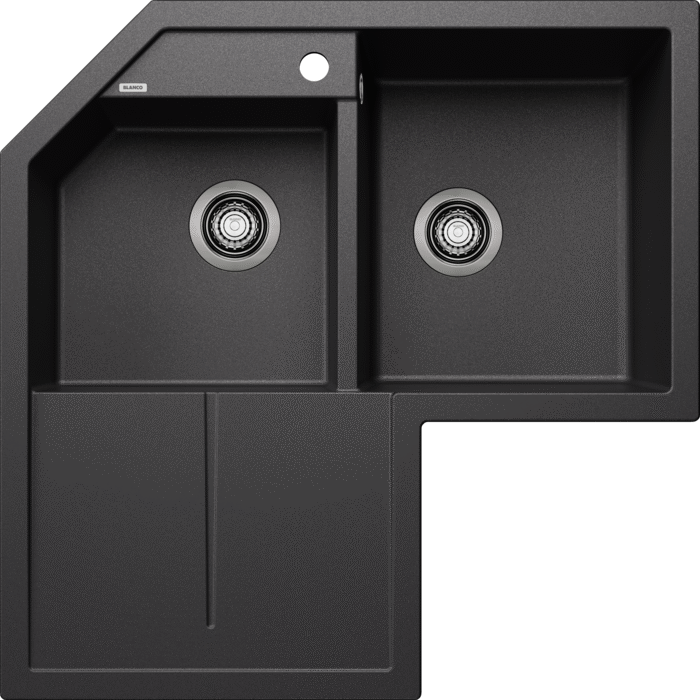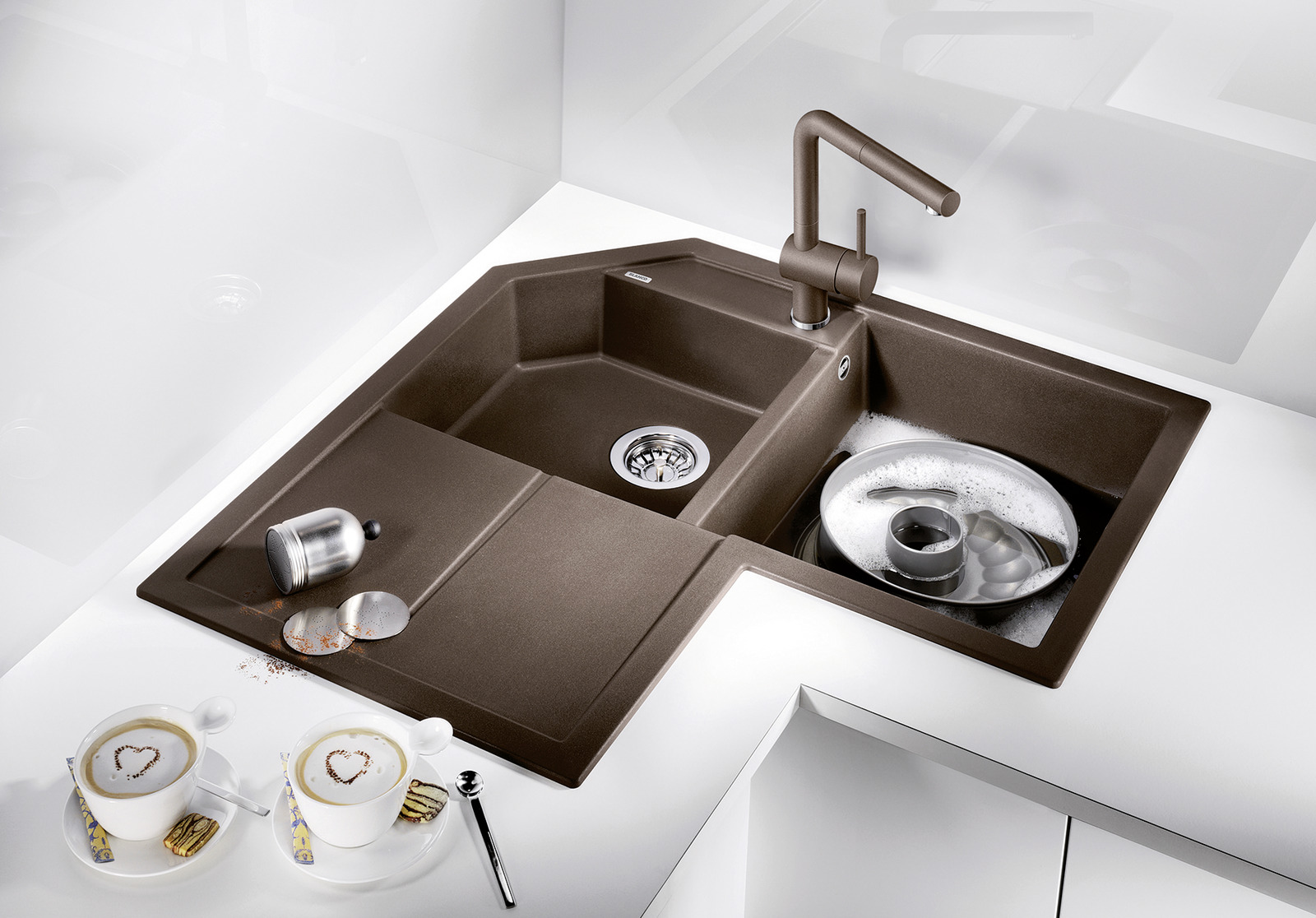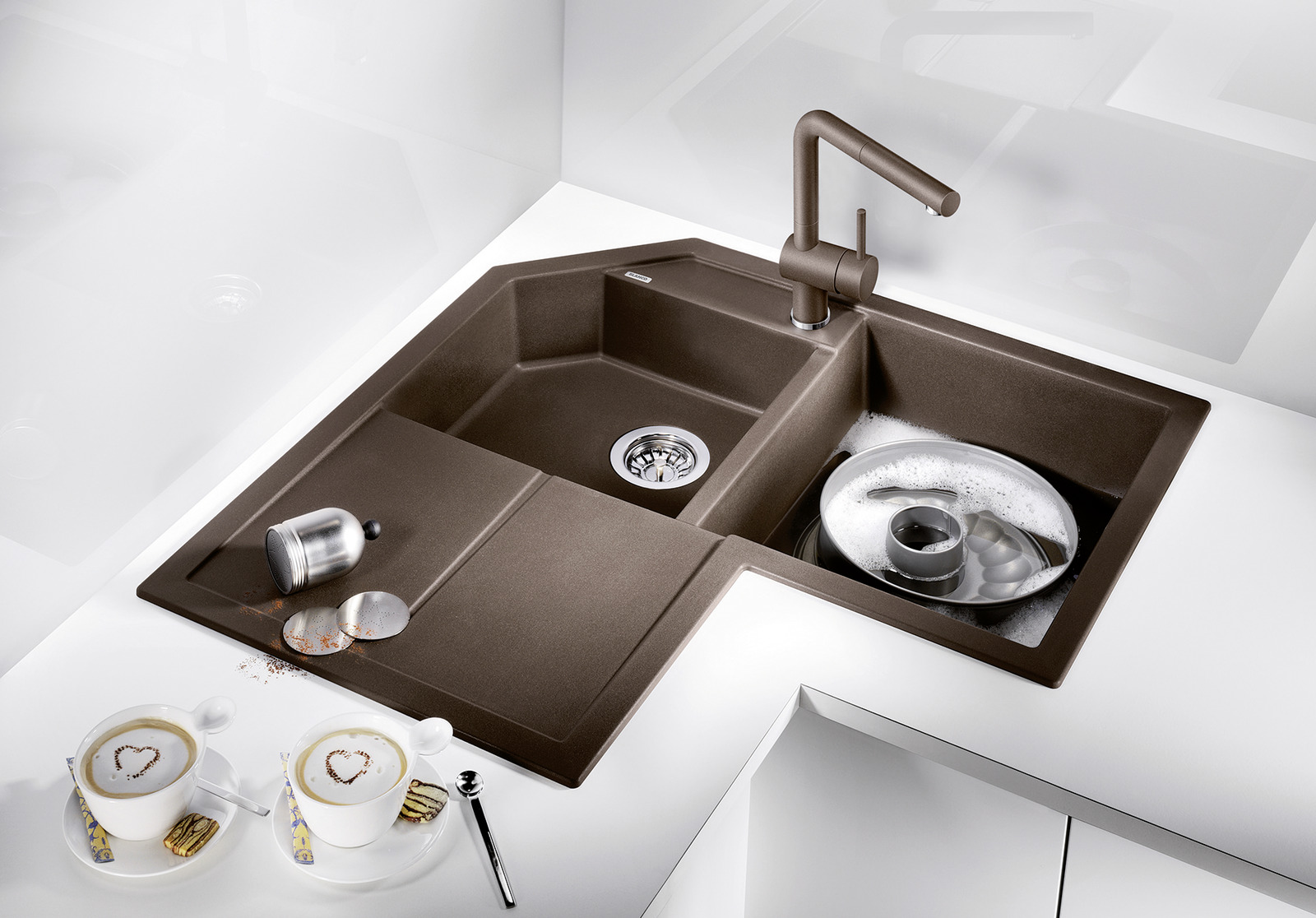METRA 9 E
- Young, straight-lined design
- Designed especially for the corner placement with comfortable large main bowl and spacious additional bowl
- Spacious draining area provides a high degree of comfort




SILGRANIT anthracite
Item no. 515576
Our granite sinks consist of Silgranit, a composite material made of up to 80 % quartz sand, the strongest component of granite. This is apparent not only to the eye, but also to the touch. Our Silgranit sinks have a lovely stone-like feel and are extremely easy to clean. What’s more, the material is highly resistant. You want to have free rein in your kitchen, whether you\'re cooking with tomatoes, strawberries, lemon juice or beetroot. Your sink is impervious to whatever ends up in it, and simply will not allow any discolouration. Only if limescale builds up on the surface of your sink you’ll need to remove it to avoid dirt accumulation. This makes your Silgranit sink an optimal synthesis of functionality and visual appeal.
Sometimes, things can really heat up in your kitchen. Silgranit can deal with the usual temperatures reached on pots, pans and baking trays when preparing food. Pots filled with boiling water, baking trays coming directly out of the oven and the like can be placed directly on the sink. Silgranit material is heat-resistant according to DIN standard 13310. The DIN standard is a uniform type of testing especially designed to check whether a product can withstand the usual chores in and around a kitchen sink. Tip: If you have an overheated pan or tray, we recommend using our top-rails or a heat pad or trivet to protect the surface of your sink and worktop from the effects of extreme heat and differences in temperature. .
Silgranit consists of 80 % quartz sand, the strongest component of granite. In short: your sink is extremely resistant. As such, you won’t need to worry about putting pots, pans and plates down wherever you fancy in your sink. You can also splash red wine, orange juice, hot coffee or beetroot juice around with abandon. Your Silgranit sink won’t mind one bit.
Yes, Silgranit is resistant to food acids. Acid-based foods like lemons and oranges can be directly prepared on the sink surface. Even vinegar or acid-based cleaning products will not harm the sink surface (i.e. citric acid, acetic acid). Remember: chloride acids or any other industrial aggressive acids might hurt your Silgranit sink and many other kitchen surface like granite, wood, paint, glass, … so please avoid using them in the kitchen.
No, Silgranit has been developed to come into contact with food and food acids. Hence there is no risk. Food acids won’t harm the sink material. Silgranit has a closed surface that blocks all common household acids. The material remains as it is. Nothing gets in and nothing comes out. And a Silgranit sink is safe for food, so no sink substances are transferred to food placed on the sink. The food won’t take on any other odour or flavor and can therefore be prepared on the sink safely.
Cutting up beetroot, chopping onions or peeling apples: things sometimes go astray when you\'re performing kitchen tasks. But your Silgranit sink is perfectly able to cope. Its secret is its fine-pored, unbroken surface. Nothing is easier than to keep your SILGRANIT sink looking brand new every day, if you follow three simple steps of cleaning. 1. Quick daily cleaning: a quick daily routine to keep your sink looking good. Simple clean it with dish soap and a soft sponge, rinse it and dry it with a microfiber cloth. 2. Easy regular clean-up: limescale is the typical challenge for a sink. With this easy clean-up you can keep weekly your Silgranit sink limescale-free. 3. Deep cleaning: once a year we recommend after the limescale removal to fill the bowl with hot water and put some liquid or gel laundry soap. Leave it overnight. Then rinse it and dry it with a microfiber cloth. It is easy to keep you Silgranit sink pristine.
Fresh fruit, vegetables and years of bright sunshine provide the surfaces of your sink with plenty of challenges as time goes on. But they remain completely indifferent. After all, our Silgranit sinks are solid as a rock. The material will not discolour or fade under normal use, and with a little care.
Yes, Silgranit comes with the built-in patented protective formula Hygiene+Plus with antibacterial properties.
SILGRANIT is made with a patented protective formula that makes its surface non-porous and thus water-repellent, dirt-repellent and easy to clean. As a result, Silgranit surface has a shield effect against bacterial growth. This is the Hygiene+Plus protection. The hygienic test* of the material Silgranit has shown that the material inhibits the formation of microbial biofilms and the growth of microorganisms on the material over time.
*Tests carried out by DHZ (German Hygiene Certificate GmbH) on behalf of and financed by BLANCO GmbH + Co KG with Bacillus subtilis, Escherichia coli, Pseudomonas aeruginosa and Staphylococcus aureus in April 2022. More details on the tests are available at blanco.com/hygiene.
Silgranit is ready to work with a hot mixer tap. Silgranit isn’t fazed by high temperatures, so boiling water won’t be a problem. A hot mixer tap like our TAMPERA delivers water at 100°C directly out of the spout, ready to make tea or cook food. Using it correctly is important to avoid injuries or putting an excessive burden on the sink. Here our experienced tips: • Always place a pot or cup below the tap before activating the boiling water and turn it off in good time to avoid spills. • Be sure to keep your hands away from the running boiling water. • Remember that the spout might be very hot after running boiling water, so avoid touching it or run some cold water before touching it. This might be very important if you have kids at home. • Move the spout of the tap to different positions to ensure that the boiling water doesn’t hit always the same spot on the sink or place a cloth on the bottom to avoid subjecting one point of the sink surface to too much boiling water.
Robust and colour-fast: these qualities define your Silgranit sink. This makes any little dark streak that appear on your surfaces all the more striking. These marks are most likely to have been caused by pots. But there’s no need to panic: you can remove such signs of abrasion in one step. After all, not only is your sink robust, but it is also extremely easy to clean. All you need is a non-scratch scrubbing sponge (we recommend the Spontex Polish, but if you don’t have it, any soft sponge will do), water, cooking oil (e.g. sunflower or rapeseed) and a microfibre cloth. Steps: • Wet the sponge completely with water • Apply oil onto the soft side of the wet sponge • Remove the dark metal marks and lines by doing circular moves with the sponge. • Remove the water and oil mixture with warm water thoroughly and dry with a microfiber cloth.
Depending on where you live and the water pipes, limescale can be quite stubborn. The unsightly water spots thus quickly become a minor blemish on your shining piece. How good that it is no trick to clean your Silgranit kitchen sink. Use citric acid, vinegar essence or our professional BLANCO DailyClean+. Apply the solution to the stains in the sink and let it soak for 5 minutes. Then rinse the sink generously, clean with a sponge and finally wipe dry.
We do our bit to make sure that you’re all set up, so our stainless steel and ceramic sinks come with a punched-out tap hole. This means that you won’t have to do any extra work before installing it. Silgranit sinks are milled from the underside. You simply have to knock through the pre-milled holes. How to do it: first place the sink in a sturdy holder. Now take a punch and place it in the middle of the mark. Use a hammer to hit the punch holes for the mixer tap, soap dispenser and drain remote control, as required, without exerting force on the punch itself. Then carefully knock the rest of the Silgranit pieces out of their marked holes. Now get a file and file the hole to the right size. You may need to do this if the hole is flush with the preliminary milling. Now there’s only one thing left to do: insert your mixer tap, and off you go.
Milky stains quickly stand out on your dark, chic sink. Limescale deposits are to blame, and they can vary in severity depending on where you live and the plumbing. These stains also like to pick up debris like coffee and tea, causing discoloration. However, this is all less bad than it sounds. If limescale or stubborn discoloration is visible, use BLANCO DailyClean+ or acid-based cleaners (as concentrated citric acid or acetic acid) to remove the limescale. Stubborn discolorations are stains fixed to lime; by removing the lime, the discoloration also disappears. To do this, spray the sink sparingly with BLANCO DailyClean+ or an acid-based cleaner and let it sit for five minutes. Then clean your sink with a sponge, rinse it with water and rub the surface dry with a microfiber cloth Note: Avoid aggressive cleaners, i.e. Strongly caustic or solvent-based cleaners, as they can attack even tough, resistant granite surfaces.
The strainer basket is the secret hero in your sink. That\'s because: it prevents your sink from clogging up, ensuring proper functionality. Over time, however, the strainer basket accumulates some dirt. Every now and then, you should therefore treat it to some care. You don\'t even have to buy a special cleaner for this. Our trick: Put a level teaspoon of a powdered dishwasher detergent on the closed strainer basket. Then pour about 250 ml of boiling water over it and let the solution soak in. Then brush and scrub (e.g. with a dish brush) until the strainer insert and drain cup shine again. Finally, open the strainer basket and remove the strainer insert. Now you have room to clean the perforations in the drain cup. When these are also sparkling clean again, reinsert the strainer insert and rinse with clean water.